Sasol Ltd.'s Global Business Strategies: An Environmental Analysis
VerifiedAdded on 2023/06/09
|9
|2706
|493
Report
AI Summary
This report provides an analysis of Sasol Ltd.'s global business environment, focusing on the factors that influence its operations and strategic decision-making. It employs McKinsey's 7S model to describe the company's governance, culture, and structure, examining how these elements affect global functioning and adaptation. The report also evaluates the influence of culture using Hofstede's Dimensions, considering sustainable and ethical factors valued by the company. Furthermore, it discusses strategic decision-making in the context of risk and diversification, outlining the range of strategic global expansion routes used by Sasol Ltd., including licensing and exporting, and concludes with insights on business expansion, cultural considerations, and effective global management.
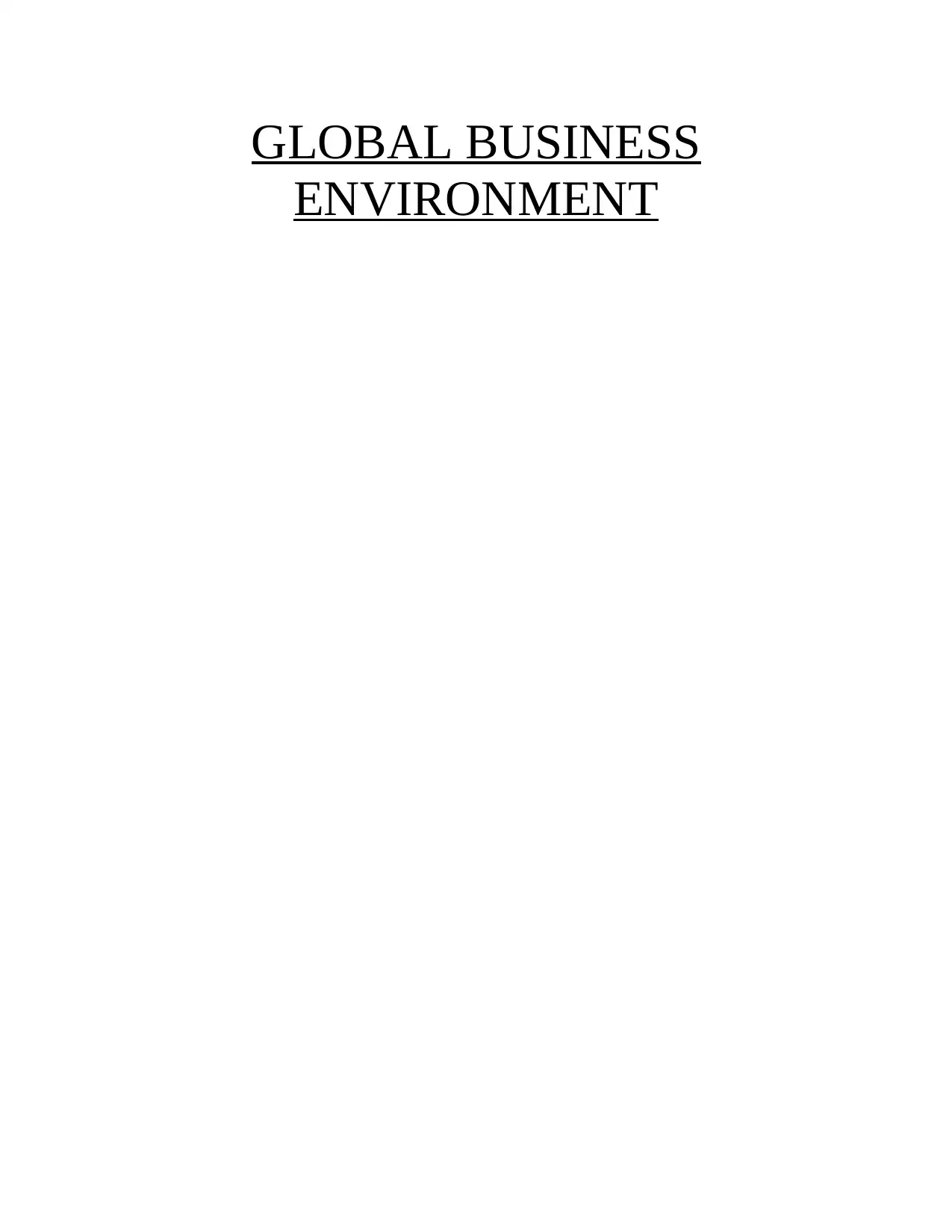
GLOBAL BUSINESS
ENVIRONMENT
ENVIRONMENT
Paraphrase This Document
Need a fresh take? Get an instant paraphrase of this document with our AI Paraphraser
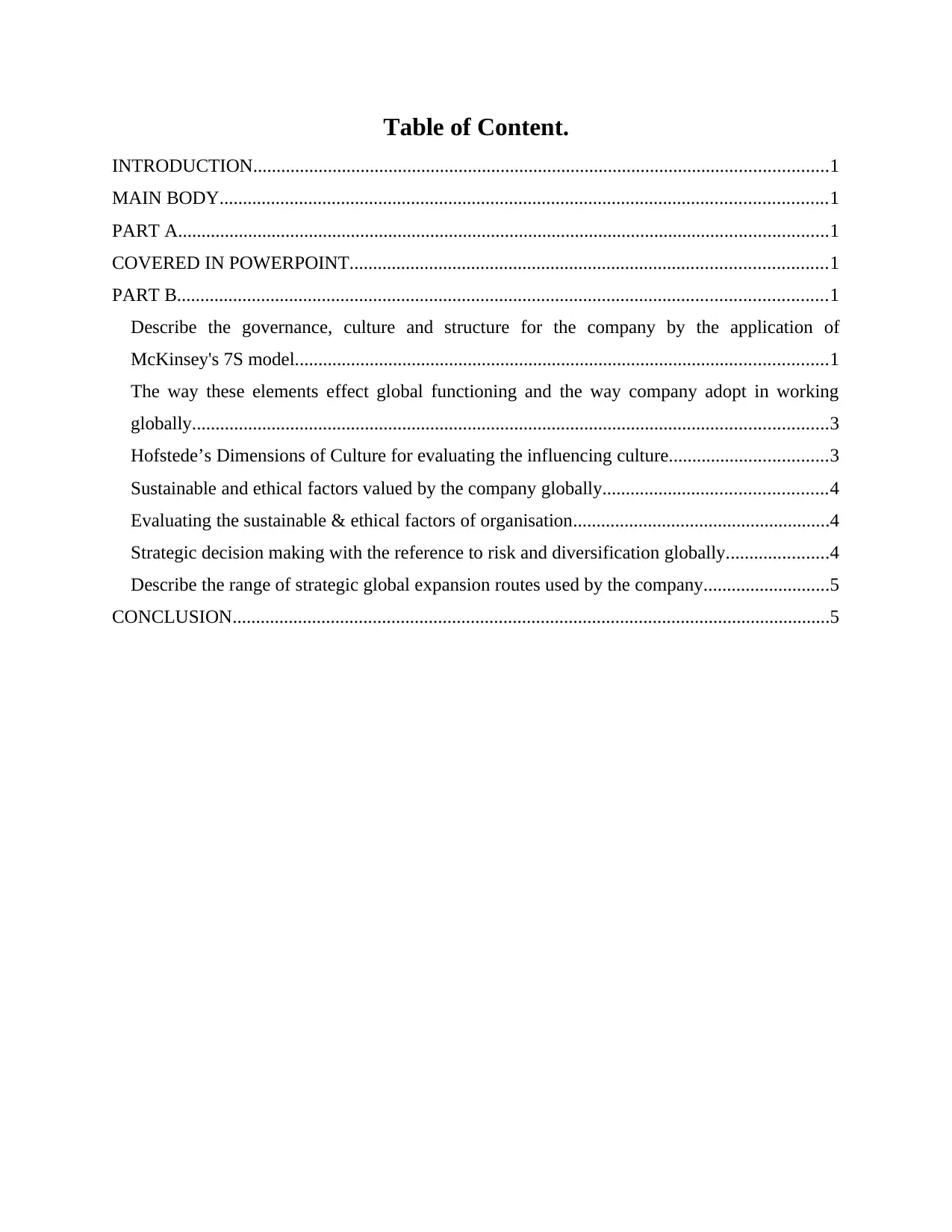
Table of Content.
INTRODUCTION...........................................................................................................................1
MAIN BODY..................................................................................................................................1
PART A...........................................................................................................................................1
COVERED IN POWERPOINT......................................................................................................1
PART B...........................................................................................................................................1
Describe the governance, culture and structure for the company by the application of
McKinsey's 7S model..................................................................................................................1
The way these elements effect global functioning and the way company adopt in working
globally........................................................................................................................................3
Hofstede’s Dimensions of Culture for evaluating the influencing culture..................................3
Sustainable and ethical factors valued by the company globally................................................4
Evaluating the sustainable & ethical factors of organisation.......................................................4
Strategic decision making with the reference to risk and diversification globally......................4
Describe the range of strategic global expansion routes used by the company...........................5
CONCLUSION................................................................................................................................5
INTRODUCTION...........................................................................................................................1
MAIN BODY..................................................................................................................................1
PART A...........................................................................................................................................1
COVERED IN POWERPOINT......................................................................................................1
PART B...........................................................................................................................................1
Describe the governance, culture and structure for the company by the application of
McKinsey's 7S model..................................................................................................................1
The way these elements effect global functioning and the way company adopt in working
globally........................................................................................................................................3
Hofstede’s Dimensions of Culture for evaluating the influencing culture..................................3
Sustainable and ethical factors valued by the company globally................................................4
Evaluating the sustainable & ethical factors of organisation.......................................................4
Strategic decision making with the reference to risk and diversification globally......................4
Describe the range of strategic global expansion routes used by the company...........................5
CONCLUSION................................................................................................................................5
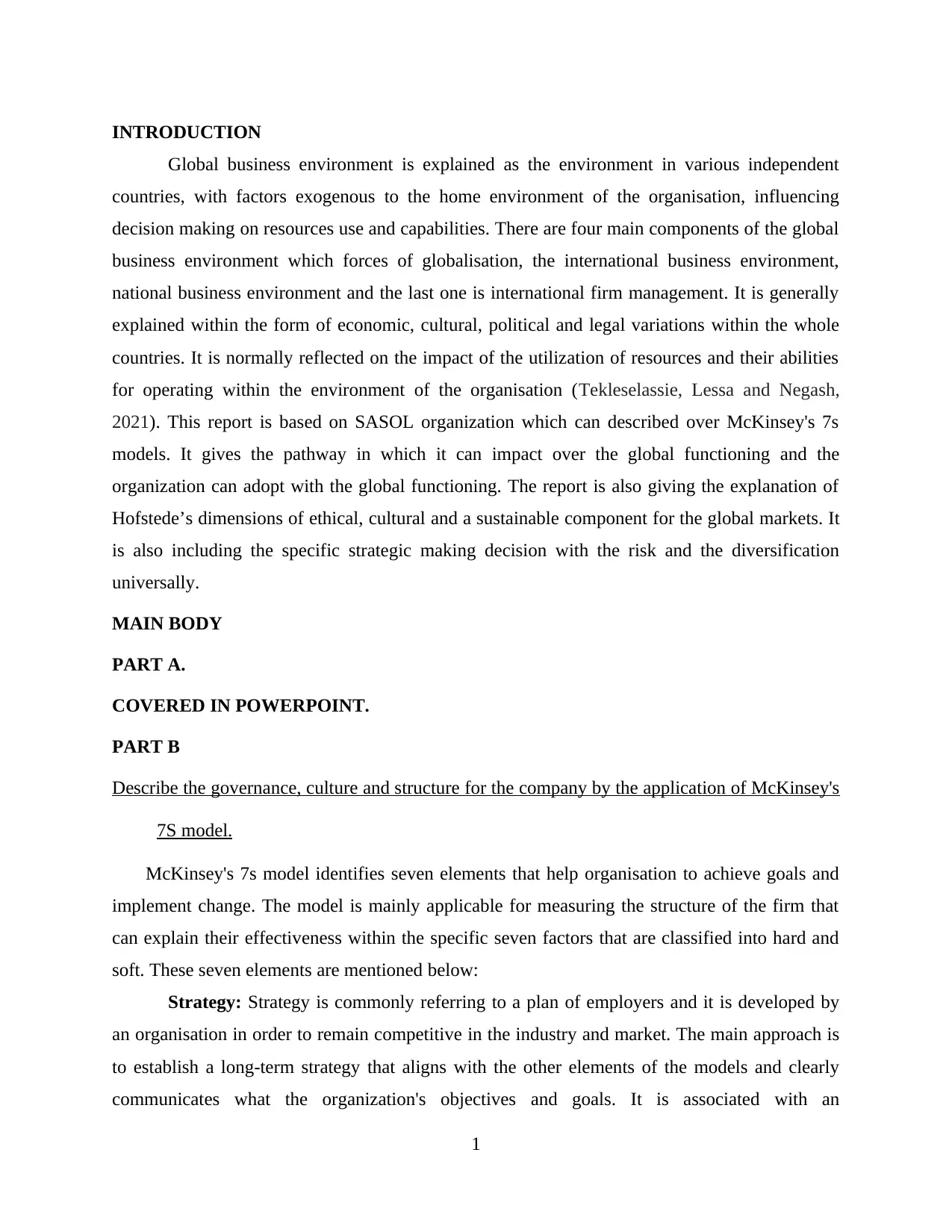
INTRODUCTION
Global business environment is explained as the environment in various independent
countries, with factors exogenous to the home environment of the organisation, influencing
decision making on resources use and capabilities. There are four main components of the global
business environment which forces of globalisation, the international business environment,
national business environment and the last one is international firm management. It is generally
explained within the form of economic, cultural, political and legal variations within the whole
countries. It is normally reflected on the impact of the utilization of resources and their abilities
for operating within the environment of the organisation (Tekleselassie, Lessa and Negash,
2021). This report is based on SASOL organization which can described over McKinsey's 7s
models. It gives the pathway in which it can impact over the global functioning and the
organization can adopt with the global functioning. The report is also giving the explanation of
Hofstede’s dimensions of ethical, cultural and a sustainable component for the global markets. It
is also including the specific strategic making decision with the risk and the diversification
universally.
MAIN BODY
PART A.
COVERED IN POWERPOINT.
PART B
Describe the governance, culture and structure for the company by the application of McKinsey's
7S model.
McKinsey's 7s model identifies seven elements that help organisation to achieve goals and
implement change. The model is mainly applicable for measuring the structure of the firm that
can explain their effectiveness within the specific seven factors that are classified into hard and
soft. These seven elements are mentioned below:
Strategy: Strategy is commonly referring to a plan of employers and it is developed by
an organisation in order to remain competitive in the industry and market. The main approach is
to establish a long-term strategy that aligns with the other elements of the models and clearly
communicates what the organization's objectives and goals. It is associated with an
1
Global business environment is explained as the environment in various independent
countries, with factors exogenous to the home environment of the organisation, influencing
decision making on resources use and capabilities. There are four main components of the global
business environment which forces of globalisation, the international business environment,
national business environment and the last one is international firm management. It is generally
explained within the form of economic, cultural, political and legal variations within the whole
countries. It is normally reflected on the impact of the utilization of resources and their abilities
for operating within the environment of the organisation (Tekleselassie, Lessa and Negash,
2021). This report is based on SASOL organization which can described over McKinsey's 7s
models. It gives the pathway in which it can impact over the global functioning and the
organization can adopt with the global functioning. The report is also giving the explanation of
Hofstede’s dimensions of ethical, cultural and a sustainable component for the global markets. It
is also including the specific strategic making decision with the risk and the diversification
universally.
MAIN BODY
PART A.
COVERED IN POWERPOINT.
PART B
Describe the governance, culture and structure for the company by the application of McKinsey's
7S model.
McKinsey's 7s model identifies seven elements that help organisation to achieve goals and
implement change. The model is mainly applicable for measuring the structure of the firm that
can explain their effectiveness within the specific seven factors that are classified into hard and
soft. These seven elements are mentioned below:
Strategy: Strategy is commonly referring to a plan of employers and it is developed by
an organisation in order to remain competitive in the industry and market. The main approach is
to establish a long-term strategy that aligns with the other elements of the models and clearly
communicates what the organization's objectives and goals. It is associated with an
1
⊘ This is a preview!⊘
Do you want full access?
Subscribe today to unlock all pages.

Trusted by 1+ million students worldwide
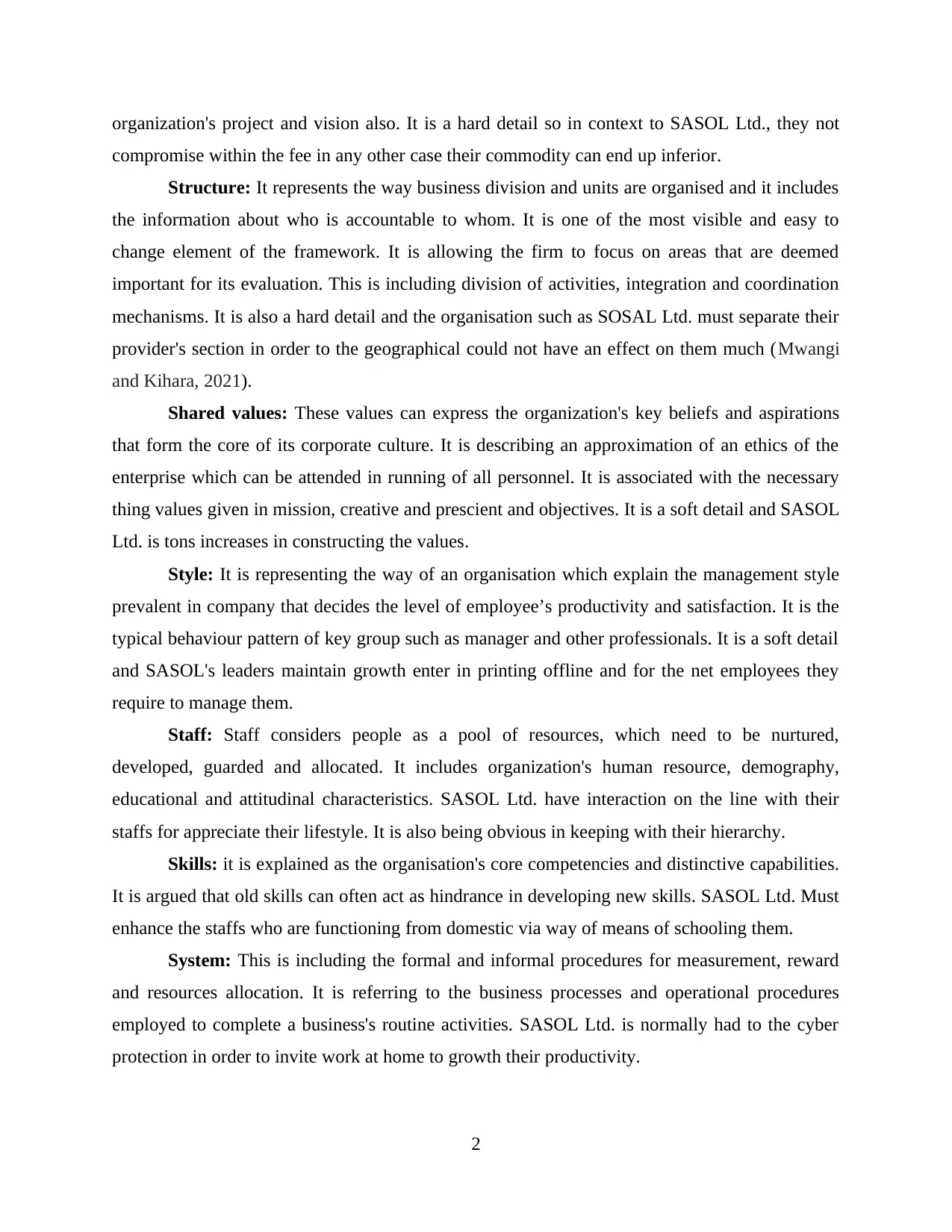
organization's project and vision also. It is a hard detail so in context to SASOL Ltd., they not
compromise within the fee in any other case their commodity can end up inferior.
Structure: It represents the way business division and units are organised and it includes
the information about who is accountable to whom. It is one of the most visible and easy to
change element of the framework. It is allowing the firm to focus on areas that are deemed
important for its evaluation. This is including division of activities, integration and coordination
mechanisms. It is also a hard detail and the organisation such as SOSAL Ltd. must separate their
provider's section in order to the geographical could not have an effect on them much (Mwangi
and Kihara, 2021).
Shared values: These values can express the organization's key beliefs and aspirations
that form the core of its corporate culture. It is describing an approximation of an ethics of the
enterprise which can be attended in running of all personnel. It is associated with the necessary
thing values given in mission, creative and prescient and objectives. It is a soft detail and SASOL
Ltd. is tons increases in constructing the values.
Style: It is representing the way of an organisation which explain the management style
prevalent in company that decides the level of employee’s productivity and satisfaction. It is the
typical behaviour pattern of key group such as manager and other professionals. It is a soft detail
and SASOL's leaders maintain growth enter in printing offline and for the net employees they
require to manage them.
Staff: Staff considers people as a pool of resources, which need to be nurtured,
developed, guarded and allocated. It includes organization's human resource, demography,
educational and attitudinal characteristics. SASOL Ltd. have interaction on the line with their
staffs for appreciate their lifestyle. It is also being obvious in keeping with their hierarchy.
Skills: it is explained as the organisation's core competencies and distinctive capabilities.
It is argued that old skills can often act as hindrance in developing new skills. SASOL Ltd. Must
enhance the staffs who are functioning from domestic via way of means of schooling them.
System: This is including the formal and informal procedures for measurement, reward
and resources allocation. It is referring to the business processes and operational procedures
employed to complete a business's routine activities. SASOL Ltd. is normally had to the cyber
protection in order to invite work at home to growth their productivity.
2
compromise within the fee in any other case their commodity can end up inferior.
Structure: It represents the way business division and units are organised and it includes
the information about who is accountable to whom. It is one of the most visible and easy to
change element of the framework. It is allowing the firm to focus on areas that are deemed
important for its evaluation. This is including division of activities, integration and coordination
mechanisms. It is also a hard detail and the organisation such as SOSAL Ltd. must separate their
provider's section in order to the geographical could not have an effect on them much (Mwangi
and Kihara, 2021).
Shared values: These values can express the organization's key beliefs and aspirations
that form the core of its corporate culture. It is describing an approximation of an ethics of the
enterprise which can be attended in running of all personnel. It is associated with the necessary
thing values given in mission, creative and prescient and objectives. It is a soft detail and SASOL
Ltd. is tons increases in constructing the values.
Style: It is representing the way of an organisation which explain the management style
prevalent in company that decides the level of employee’s productivity and satisfaction. It is the
typical behaviour pattern of key group such as manager and other professionals. It is a soft detail
and SASOL's leaders maintain growth enter in printing offline and for the net employees they
require to manage them.
Staff: Staff considers people as a pool of resources, which need to be nurtured,
developed, guarded and allocated. It includes organization's human resource, demography,
educational and attitudinal characteristics. SASOL Ltd. have interaction on the line with their
staffs for appreciate their lifestyle. It is also being obvious in keeping with their hierarchy.
Skills: it is explained as the organisation's core competencies and distinctive capabilities.
It is argued that old skills can often act as hindrance in developing new skills. SASOL Ltd. Must
enhance the staffs who are functioning from domestic via way of means of schooling them.
System: This is including the formal and informal procedures for measurement, reward
and resources allocation. It is referring to the business processes and operational procedures
employed to complete a business's routine activities. SASOL Ltd. is normally had to the cyber
protection in order to invite work at home to growth their productivity.
2
Paraphrase This Document
Need a fresh take? Get an instant paraphrase of this document with our AI Paraphraser
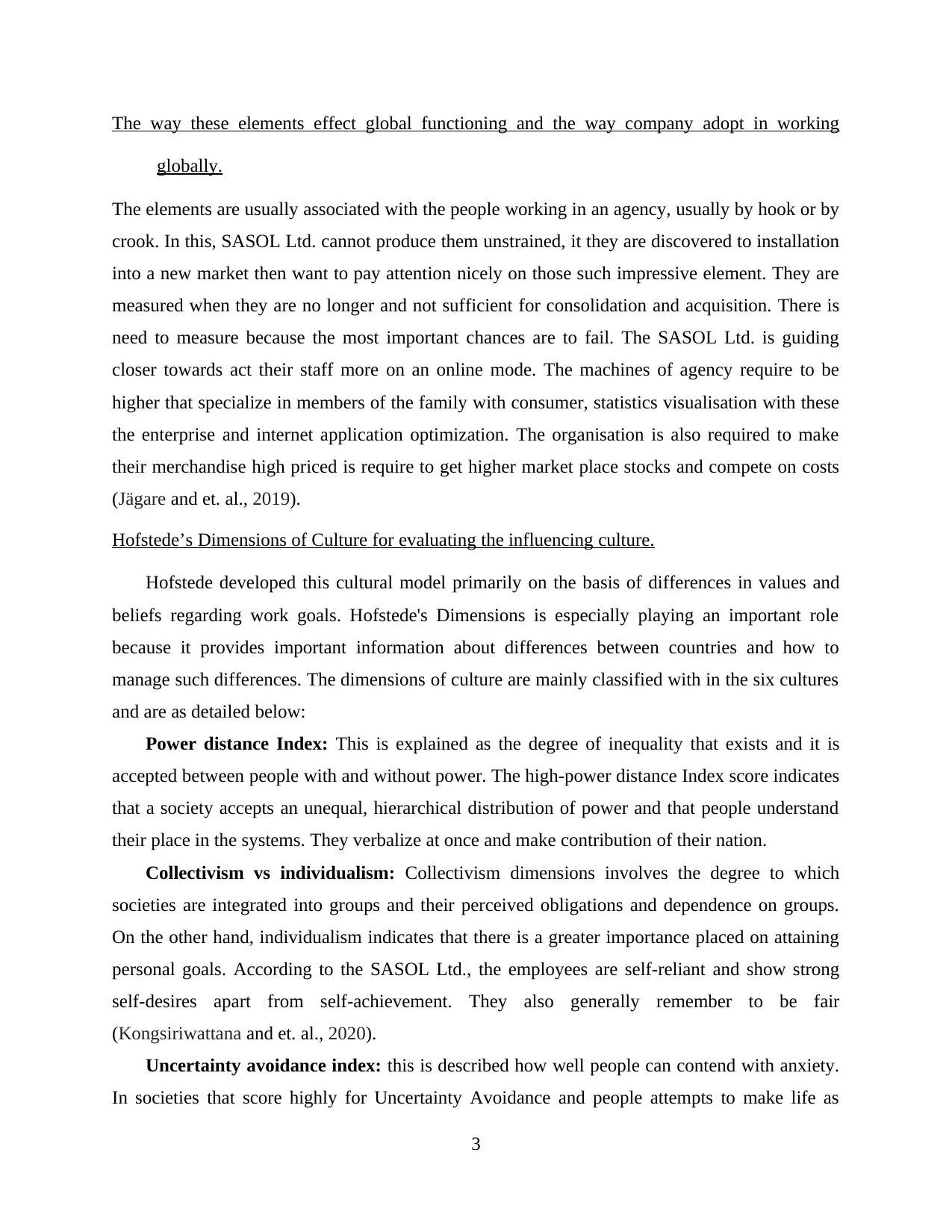
The way these elements effect global functioning and the way company adopt in working
globally.
The elements are usually associated with the people working in an agency, usually by hook or by
crook. In this, SASOL Ltd. cannot produce them unstrained, it they are discovered to installation
into a new market then want to pay attention nicely on those such impressive element. They are
measured when they are no longer and not sufficient for consolidation and acquisition. There is
need to measure because the most important chances are to fail. The SASOL Ltd. is guiding
closer towards act their staff more on an online mode. The machines of agency require to be
higher that specialize in members of the family with consumer, statistics visualisation with these
the enterprise and internet application optimization. The organisation is also required to make
their merchandise high priced is require to get higher market place stocks and compete on costs
(Jägare and et. al., 2019).
Hofstede’s Dimensions of Culture for evaluating the influencing culture.
Hofstede developed this cultural model primarily on the basis of differences in values and
beliefs regarding work goals. Hofstede's Dimensions is especially playing an important role
because it provides important information about differences between countries and how to
manage such differences. The dimensions of culture are mainly classified with in the six cultures
and are as detailed below:
Power distance Index: This is explained as the degree of inequality that exists and it is
accepted between people with and without power. The high-power distance Index score indicates
that a society accepts an unequal, hierarchical distribution of power and that people understand
their place in the systems. They verbalize at once and make contribution of their nation.
Collectivism vs individualism: Collectivism dimensions involves the degree to which
societies are integrated into groups and their perceived obligations and dependence on groups.
On the other hand, individualism indicates that there is a greater importance placed on attaining
personal goals. According to the SASOL Ltd., the employees are self-reliant and show strong
self-desires apart from self-achievement. They also generally remember to be fair
(Kongsiriwattana and et. al., 2020).
Uncertainty avoidance index: this is described how well people can contend with anxiety.
In societies that score highly for Uncertainty Avoidance and people attempts to make life as
3
globally.
The elements are usually associated with the people working in an agency, usually by hook or by
crook. In this, SASOL Ltd. cannot produce them unstrained, it they are discovered to installation
into a new market then want to pay attention nicely on those such impressive element. They are
measured when they are no longer and not sufficient for consolidation and acquisition. There is
need to measure because the most important chances are to fail. The SASOL Ltd. is guiding
closer towards act their staff more on an online mode. The machines of agency require to be
higher that specialize in members of the family with consumer, statistics visualisation with these
the enterprise and internet application optimization. The organisation is also required to make
their merchandise high priced is require to get higher market place stocks and compete on costs
(Jägare and et. al., 2019).
Hofstede’s Dimensions of Culture for evaluating the influencing culture.
Hofstede developed this cultural model primarily on the basis of differences in values and
beliefs regarding work goals. Hofstede's Dimensions is especially playing an important role
because it provides important information about differences between countries and how to
manage such differences. The dimensions of culture are mainly classified with in the six cultures
and are as detailed below:
Power distance Index: This is explained as the degree of inequality that exists and it is
accepted between people with and without power. The high-power distance Index score indicates
that a society accepts an unequal, hierarchical distribution of power and that people understand
their place in the systems. They verbalize at once and make contribution of their nation.
Collectivism vs individualism: Collectivism dimensions involves the degree to which
societies are integrated into groups and their perceived obligations and dependence on groups.
On the other hand, individualism indicates that there is a greater importance placed on attaining
personal goals. According to the SASOL Ltd., the employees are self-reliant and show strong
self-desires apart from self-achievement. They also generally remember to be fair
(Kongsiriwattana and et. al., 2020).
Uncertainty avoidance index: this is described how well people can contend with anxiety.
In societies that score highly for Uncertainty Avoidance and people attempts to make life as
3
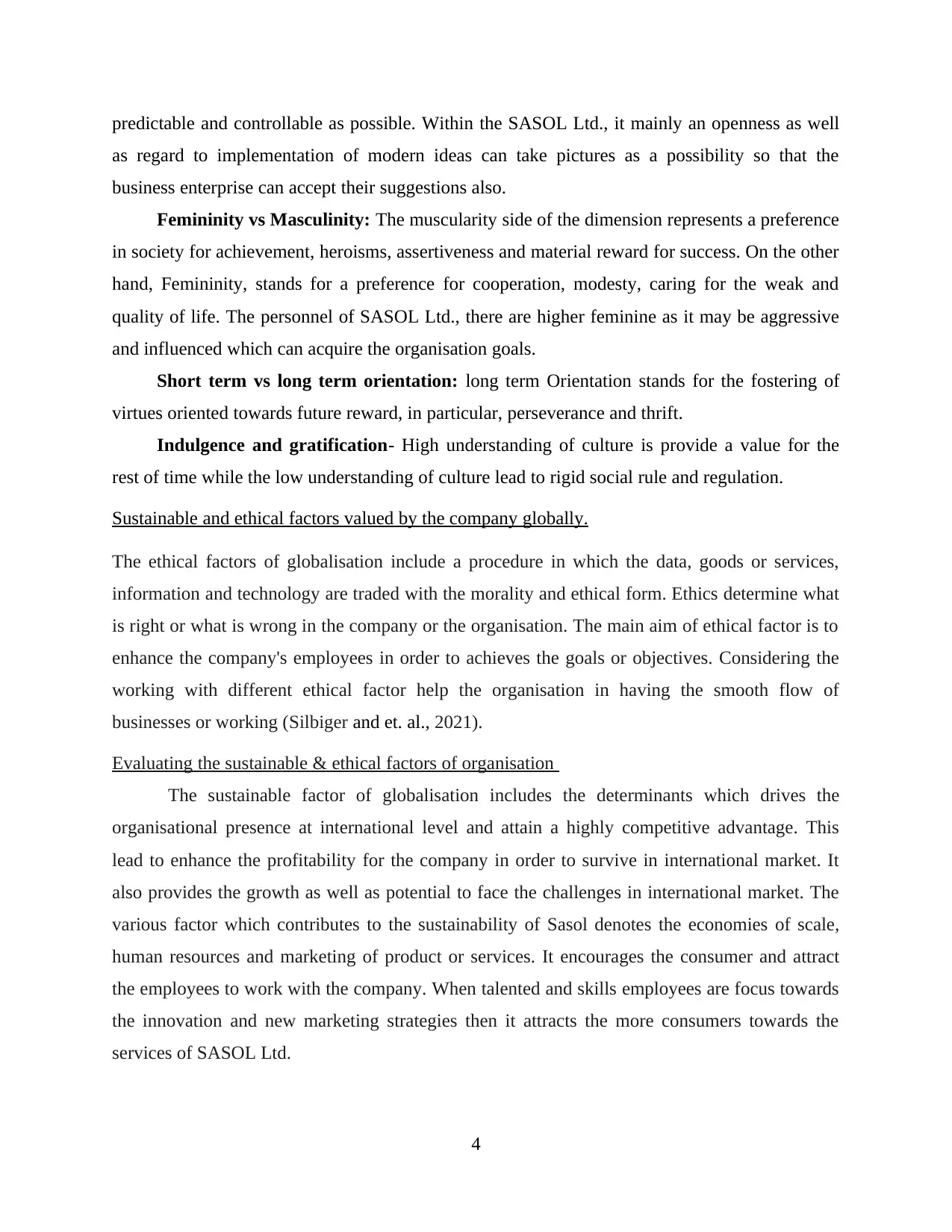
predictable and controllable as possible. Within the SASOL Ltd., it mainly an openness as well
as regard to implementation of modern ideas can take pictures as a possibility so that the
business enterprise can accept their suggestions also.
Femininity vs Masculinity: The muscularity side of the dimension represents a preference
in society for achievement, heroisms, assertiveness and material reward for success. On the other
hand, Femininity, stands for a preference for cooperation, modesty, caring for the weak and
quality of life. The personnel of SASOL Ltd., there are higher feminine as it may be aggressive
and influenced which can acquire the organisation goals.
Short term vs long term orientation: long term Orientation stands for the fostering of
virtues oriented towards future reward, in particular, perseverance and thrift.
Indulgence and gratification- High understanding of culture is provide a value for the
rest of time while the low understanding of culture lead to rigid social rule and regulation.
Sustainable and ethical factors valued by the company globally.
The ethical factors of globalisation include a procedure in which the data, goods or services,
information and technology are traded with the morality and ethical form. Ethics determine what
is right or what is wrong in the company or the organisation. The main aim of ethical factor is to
enhance the company's employees in order to achieves the goals or objectives. Considering the
working with different ethical factor help the organisation in having the smooth flow of
businesses or working (Silbiger and et. al., 2021).
Evaluating the sustainable & ethical factors of organisation
The sustainable factor of globalisation includes the determinants which drives the
organisational presence at international level and attain a highly competitive advantage. This
lead to enhance the profitability for the company in order to survive in international market. It
also provides the growth as well as potential to face the challenges in international market. The
various factor which contributes to the sustainability of Sasol denotes the economies of scale,
human resources and marketing of product or services. It encourages the consumer and attract
the employees to work with the company. When talented and skills employees are focus towards
the innovation and new marketing strategies then it attracts the more consumers towards the
services of SASOL Ltd.
4
as regard to implementation of modern ideas can take pictures as a possibility so that the
business enterprise can accept their suggestions also.
Femininity vs Masculinity: The muscularity side of the dimension represents a preference
in society for achievement, heroisms, assertiveness and material reward for success. On the other
hand, Femininity, stands for a preference for cooperation, modesty, caring for the weak and
quality of life. The personnel of SASOL Ltd., there are higher feminine as it may be aggressive
and influenced which can acquire the organisation goals.
Short term vs long term orientation: long term Orientation stands for the fostering of
virtues oriented towards future reward, in particular, perseverance and thrift.
Indulgence and gratification- High understanding of culture is provide a value for the
rest of time while the low understanding of culture lead to rigid social rule and regulation.
Sustainable and ethical factors valued by the company globally.
The ethical factors of globalisation include a procedure in which the data, goods or services,
information and technology are traded with the morality and ethical form. Ethics determine what
is right or what is wrong in the company or the organisation. The main aim of ethical factor is to
enhance the company's employees in order to achieves the goals or objectives. Considering the
working with different ethical factor help the organisation in having the smooth flow of
businesses or working (Silbiger and et. al., 2021).
Evaluating the sustainable & ethical factors of organisation
The sustainable factor of globalisation includes the determinants which drives the
organisational presence at international level and attain a highly competitive advantage. This
lead to enhance the profitability for the company in order to survive in international market. It
also provides the growth as well as potential to face the challenges in international market. The
various factor which contributes to the sustainability of Sasol denotes the economies of scale,
human resources and marketing of product or services. It encourages the consumer and attract
the employees to work with the company. When talented and skills employees are focus towards
the innovation and new marketing strategies then it attracts the more consumers towards the
services of SASOL Ltd.
4
⊘ This is a preview!⊘
Do you want full access?
Subscribe today to unlock all pages.

Trusted by 1+ million students worldwide
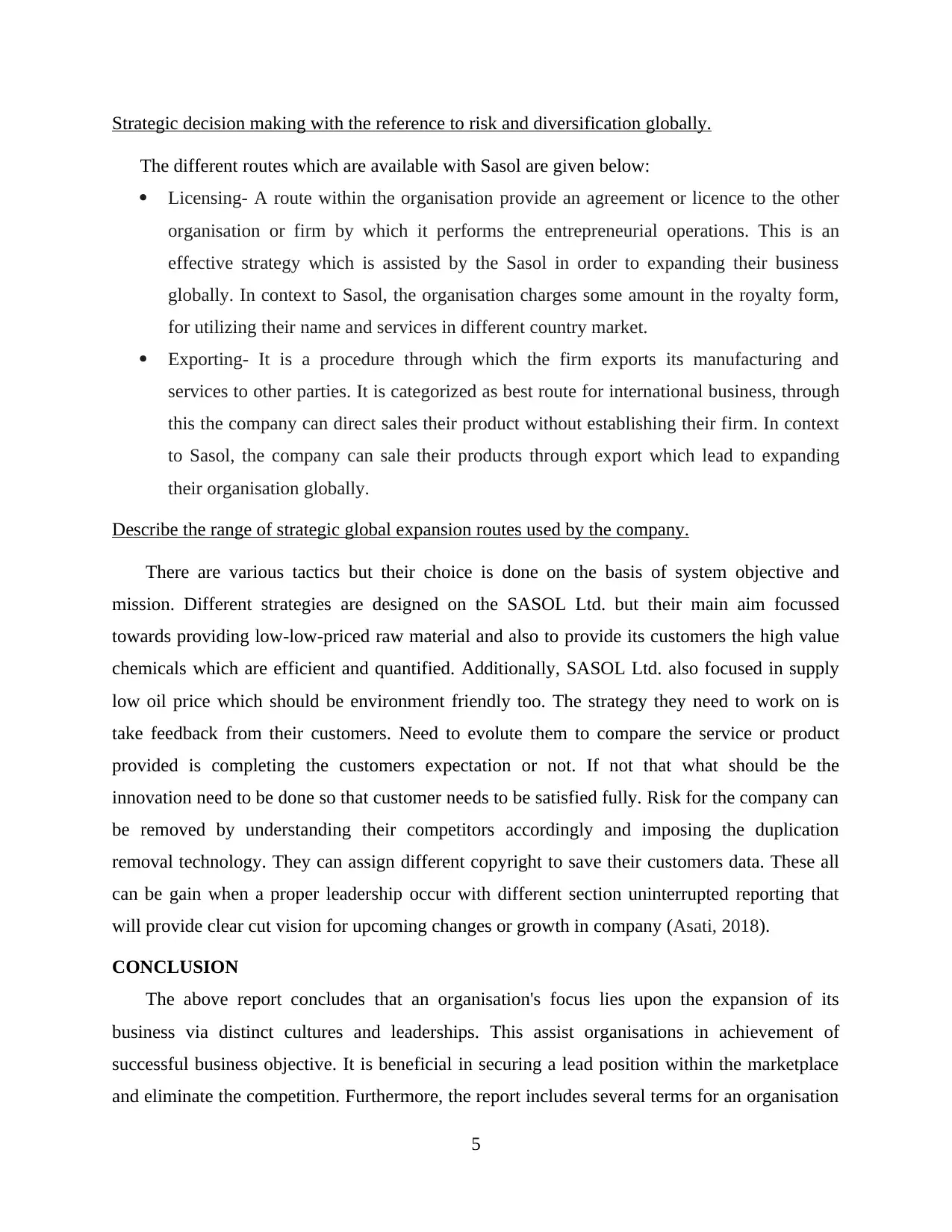
Strategic decision making with the reference to risk and diversification globally.
The different routes which are available with Sasol are given below:
Licensing- A route within the organisation provide an agreement or licence to the other
organisation or firm by which it performs the entrepreneurial operations. This is an
effective strategy which is assisted by the Sasol in order to expanding their business
globally. In context to Sasol, the organisation charges some amount in the royalty form,
for utilizing their name and services in different country market.
Exporting- It is a procedure through which the firm exports its manufacturing and
services to other parties. It is categorized as best route for international business, through
this the company can direct sales their product without establishing their firm. In context
to Sasol, the company can sale their products through export which lead to expanding
their organisation globally.
Describe the range of strategic global expansion routes used by the company.
There are various tactics but their choice is done on the basis of system objective and
mission. Different strategies are designed on the SASOL Ltd. but their main aim focussed
towards providing low-low-priced raw material and also to provide its customers the high value
chemicals which are efficient and quantified. Additionally, SASOL Ltd. also focused in supply
low oil price which should be environment friendly too. The strategy they need to work on is
take feedback from their customers. Need to evolute them to compare the service or product
provided is completing the customers expectation or not. If not that what should be the
innovation need to be done so that customer needs to be satisfied fully. Risk for the company can
be removed by understanding their competitors accordingly and imposing the duplication
removal technology. They can assign different copyright to save their customers data. These all
can be gain when a proper leadership occur with different section uninterrupted reporting that
will provide clear cut vision for upcoming changes or growth in company (Asati, 2018).
CONCLUSION
The above report concludes that an organisation's focus lies upon the expansion of its
business via distinct cultures and leaderships. This assist organisations in achievement of
successful business objective. It is beneficial in securing a lead position within the marketplace
and eliminate the competition. Furthermore, the report includes several terms for an organisation
5
The different routes which are available with Sasol are given below:
Licensing- A route within the organisation provide an agreement or licence to the other
organisation or firm by which it performs the entrepreneurial operations. This is an
effective strategy which is assisted by the Sasol in order to expanding their business
globally. In context to Sasol, the organisation charges some amount in the royalty form,
for utilizing their name and services in different country market.
Exporting- It is a procedure through which the firm exports its manufacturing and
services to other parties. It is categorized as best route for international business, through
this the company can direct sales their product without establishing their firm. In context
to Sasol, the company can sale their products through export which lead to expanding
their organisation globally.
Describe the range of strategic global expansion routes used by the company.
There are various tactics but their choice is done on the basis of system objective and
mission. Different strategies are designed on the SASOL Ltd. but their main aim focussed
towards providing low-low-priced raw material and also to provide its customers the high value
chemicals which are efficient and quantified. Additionally, SASOL Ltd. also focused in supply
low oil price which should be environment friendly too. The strategy they need to work on is
take feedback from their customers. Need to evolute them to compare the service or product
provided is completing the customers expectation or not. If not that what should be the
innovation need to be done so that customer needs to be satisfied fully. Risk for the company can
be removed by understanding their competitors accordingly and imposing the duplication
removal technology. They can assign different copyright to save their customers data. These all
can be gain when a proper leadership occur with different section uninterrupted reporting that
will provide clear cut vision for upcoming changes or growth in company (Asati, 2018).
CONCLUSION
The above report concludes that an organisation's focus lies upon the expansion of its
business via distinct cultures and leaderships. This assist organisations in achievement of
successful business objective. It is beneficial in securing a lead position within the marketplace
and eliminate the competition. Furthermore, the report includes several terms for an organisation
5
Paraphrase This Document
Need a fresh take? Get an instant paraphrase of this document with our AI Paraphraser
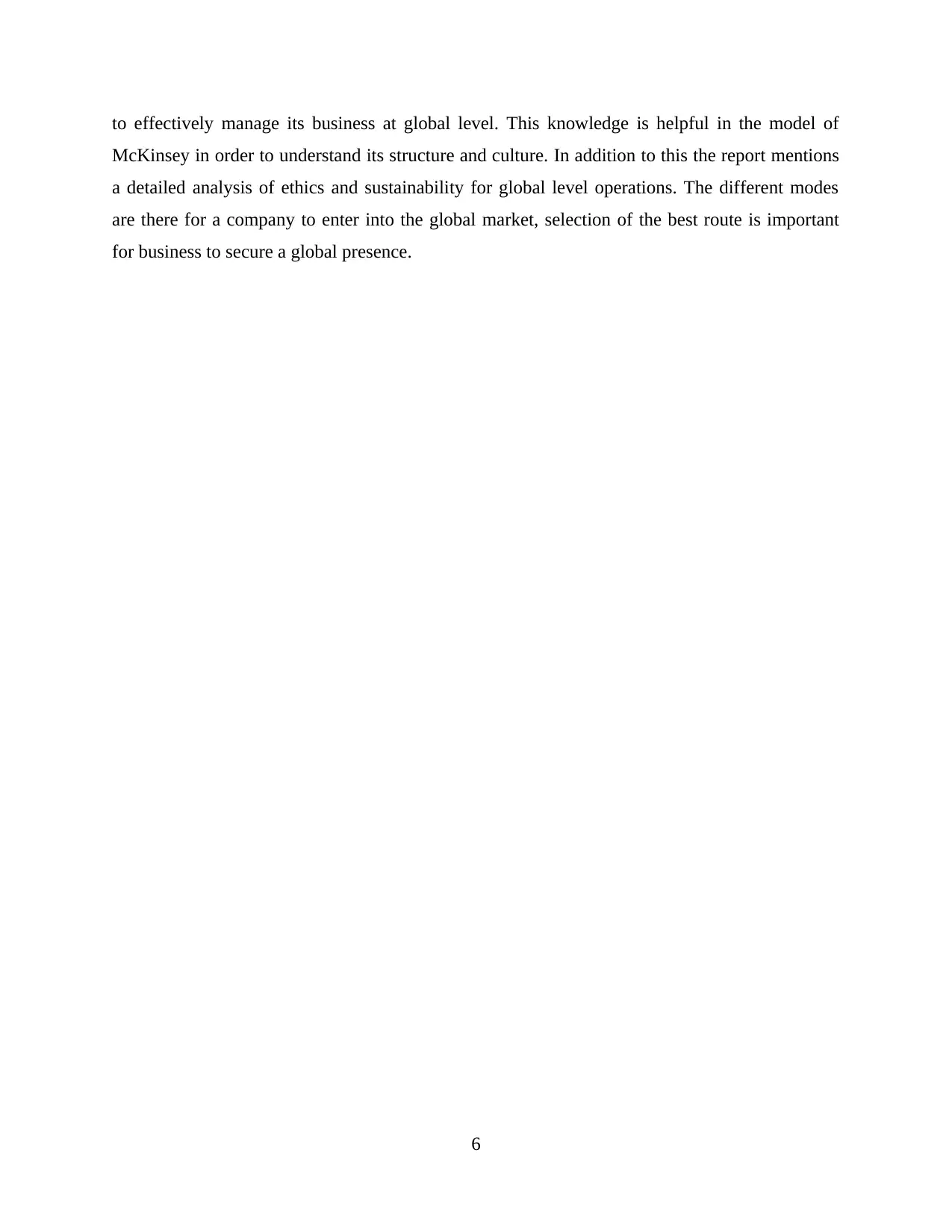
to effectively manage its business at global level. This knowledge is helpful in the model of
McKinsey in order to understand its structure and culture. In addition to this the report mentions
a detailed analysis of ethics and sustainability for global level operations. The different modes
are there for a company to enter into the global market, selection of the best route is important
for business to secure a global presence.
6
McKinsey in order to understand its structure and culture. In addition to this the report mentions
a detailed analysis of ethics and sustainability for global level operations. The different modes
are there for a company to enter into the global market, selection of the best route is important
for business to secure a global presence.
6
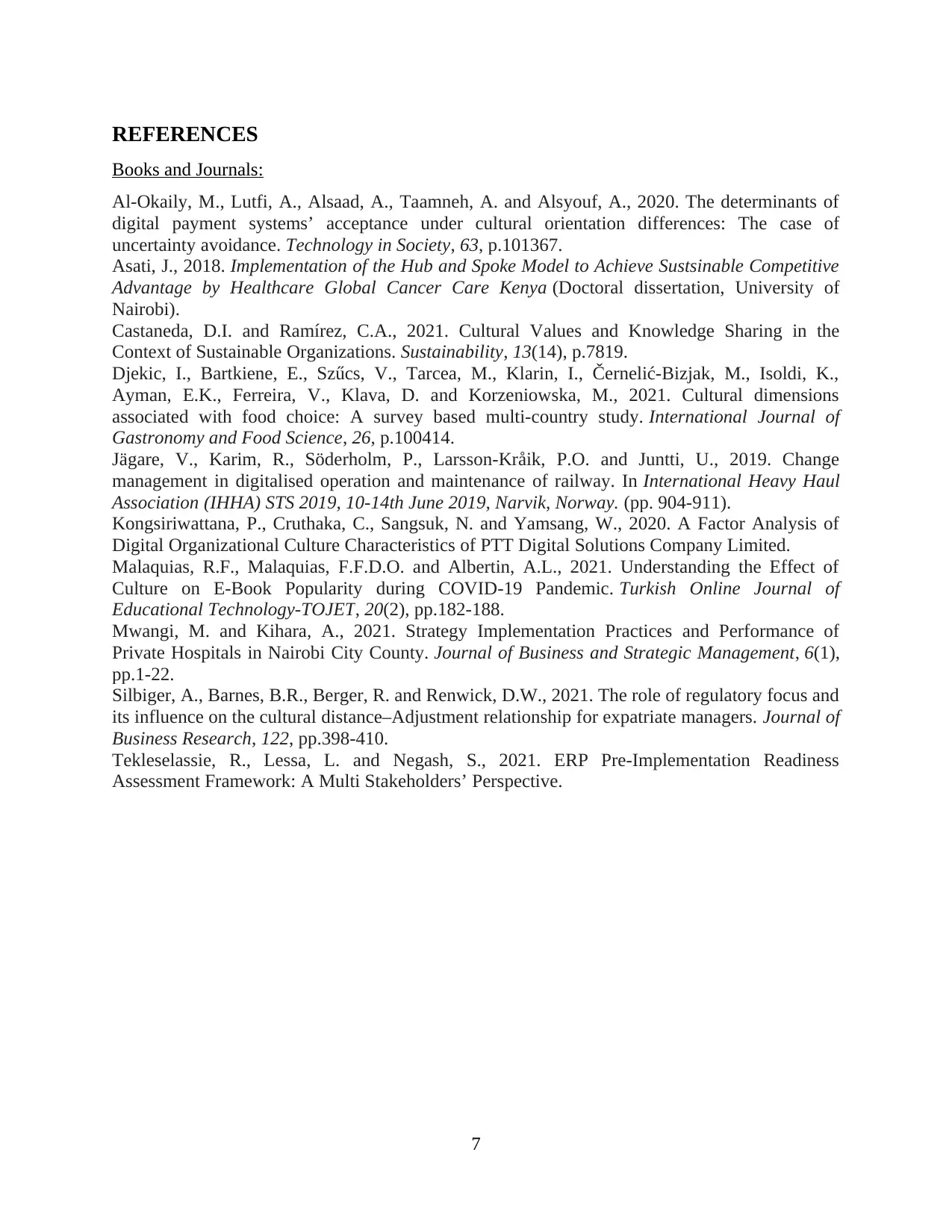
REFERENCES
Books and Journals:
Al-Okaily, M., Lutfi, A., Alsaad, A., Taamneh, A. and Alsyouf, A., 2020. The determinants of
digital payment systems’ acceptance under cultural orientation differences: The case of
uncertainty avoidance. Technology in Society, 63, p.101367.
Asati, J., 2018. Implementation of the Hub and Spoke Model to Achieve Sustsinable Competitive
Advantage by Healthcare Global Cancer Care Kenya (Doctoral dissertation, University of
Nairobi).
Castaneda, D.I. and Ramírez, C.A., 2021. Cultural Values and Knowledge Sharing in the
Context of Sustainable Organizations. Sustainability, 13(14), p.7819.
Djekic, I., Bartkiene, E., Szűcs, V., Tarcea, M., Klarin, I., Černelić-Bizjak, M., Isoldi, K.,
Ayman, E.K., Ferreira, V., Klava, D. and Korzeniowska, M., 2021. Cultural dimensions
associated with food choice: A survey based multi-country study. International Journal of
Gastronomy and Food Science, 26, p.100414.
Jägare, V., Karim, R., Söderholm, P., Larsson-Kråik, P.O. and Juntti, U., 2019. Change
management in digitalised operation and maintenance of railway. In International Heavy Haul
Association (IHHA) STS 2019, 10-14th June 2019, Narvik, Norway. (pp. 904-911).
Kongsiriwattana, P., Cruthaka, C., Sangsuk, N. and Yamsang, W., 2020. A Factor Analysis of
Digital Organizational Culture Characteristics of PTT Digital Solutions Company Limited.
Malaquias, R.F., Malaquias, F.F.D.O. and Albertin, A.L., 2021. Understanding the Effect of
Culture on E-Book Popularity during COVID-19 Pandemic. Turkish Online Journal of
Educational Technology-TOJET, 20(2), pp.182-188.
Mwangi, M. and Kihara, A., 2021. Strategy Implementation Practices and Performance of
Private Hospitals in Nairobi City County. Journal of Business and Strategic Management, 6(1),
pp.1-22.
Silbiger, A., Barnes, B.R., Berger, R. and Renwick, D.W., 2021. The role of regulatory focus and
its influence on the cultural distance–Adjustment relationship for expatriate managers. Journal of
Business Research, 122, pp.398-410.
Tekleselassie, R., Lessa, L. and Negash, S., 2021. ERP Pre-Implementation Readiness
Assessment Framework: A Multi Stakeholders’ Perspective.
7
Books and Journals:
Al-Okaily, M., Lutfi, A., Alsaad, A., Taamneh, A. and Alsyouf, A., 2020. The determinants of
digital payment systems’ acceptance under cultural orientation differences: The case of
uncertainty avoidance. Technology in Society, 63, p.101367.
Asati, J., 2018. Implementation of the Hub and Spoke Model to Achieve Sustsinable Competitive
Advantage by Healthcare Global Cancer Care Kenya (Doctoral dissertation, University of
Nairobi).
Castaneda, D.I. and Ramírez, C.A., 2021. Cultural Values and Knowledge Sharing in the
Context of Sustainable Organizations. Sustainability, 13(14), p.7819.
Djekic, I., Bartkiene, E., Szűcs, V., Tarcea, M., Klarin, I., Černelić-Bizjak, M., Isoldi, K.,
Ayman, E.K., Ferreira, V., Klava, D. and Korzeniowska, M., 2021. Cultural dimensions
associated with food choice: A survey based multi-country study. International Journal of
Gastronomy and Food Science, 26, p.100414.
Jägare, V., Karim, R., Söderholm, P., Larsson-Kråik, P.O. and Juntti, U., 2019. Change
management in digitalised operation and maintenance of railway. In International Heavy Haul
Association (IHHA) STS 2019, 10-14th June 2019, Narvik, Norway. (pp. 904-911).
Kongsiriwattana, P., Cruthaka, C., Sangsuk, N. and Yamsang, W., 2020. A Factor Analysis of
Digital Organizational Culture Characteristics of PTT Digital Solutions Company Limited.
Malaquias, R.F., Malaquias, F.F.D.O. and Albertin, A.L., 2021. Understanding the Effect of
Culture on E-Book Popularity during COVID-19 Pandemic. Turkish Online Journal of
Educational Technology-TOJET, 20(2), pp.182-188.
Mwangi, M. and Kihara, A., 2021. Strategy Implementation Practices and Performance of
Private Hospitals in Nairobi City County. Journal of Business and Strategic Management, 6(1),
pp.1-22.
Silbiger, A., Barnes, B.R., Berger, R. and Renwick, D.W., 2021. The role of regulatory focus and
its influence on the cultural distance–Adjustment relationship for expatriate managers. Journal of
Business Research, 122, pp.398-410.
Tekleselassie, R., Lessa, L. and Negash, S., 2021. ERP Pre-Implementation Readiness
Assessment Framework: A Multi Stakeholders’ Perspective.
7
⊘ This is a preview!⊘
Do you want full access?
Subscribe today to unlock all pages.

Trusted by 1+ million students worldwide
1 out of 9
Related Documents
Your All-in-One AI-Powered Toolkit for Academic Success.
+13062052269
info@desklib.com
Available 24*7 on WhatsApp / Email
![[object Object]](/_next/static/media/star-bottom.7253800d.svg)
Unlock your academic potential
Copyright © 2020–2025 A2Z Services. All Rights Reserved. Developed and managed by ZUCOL.

